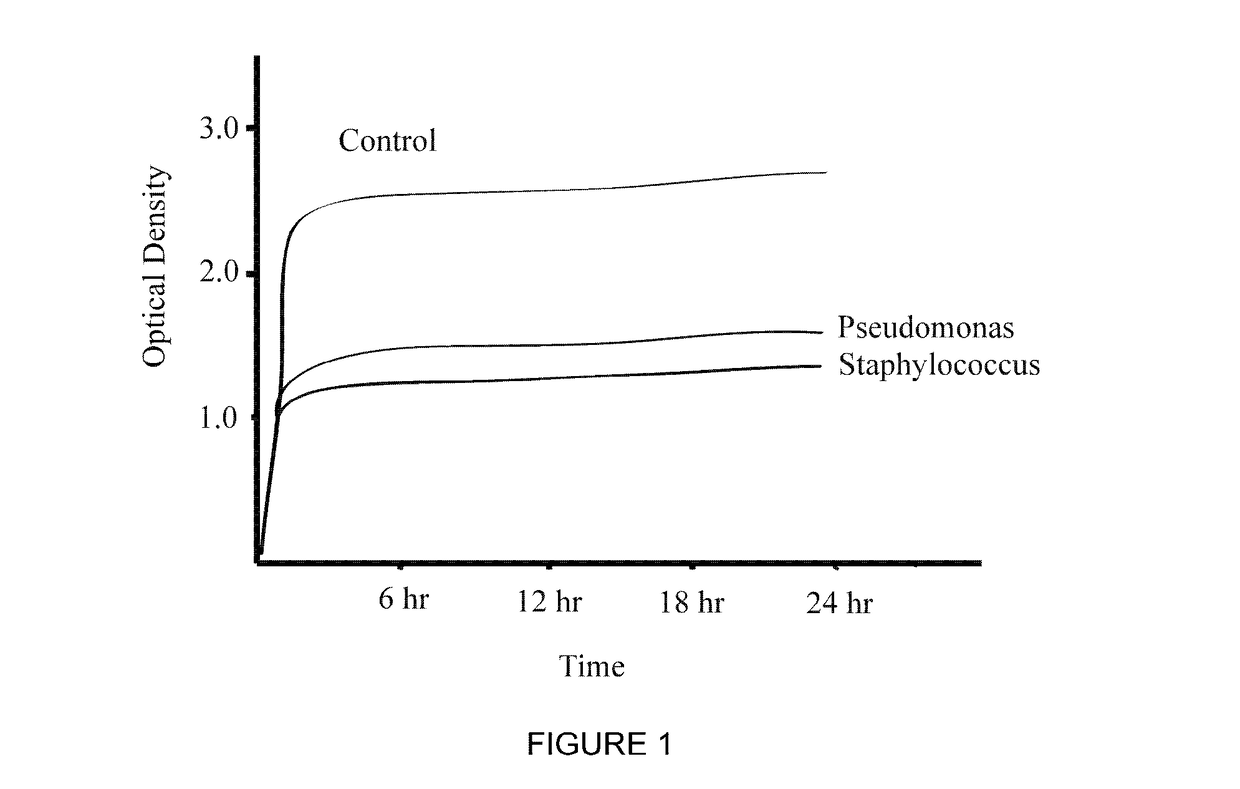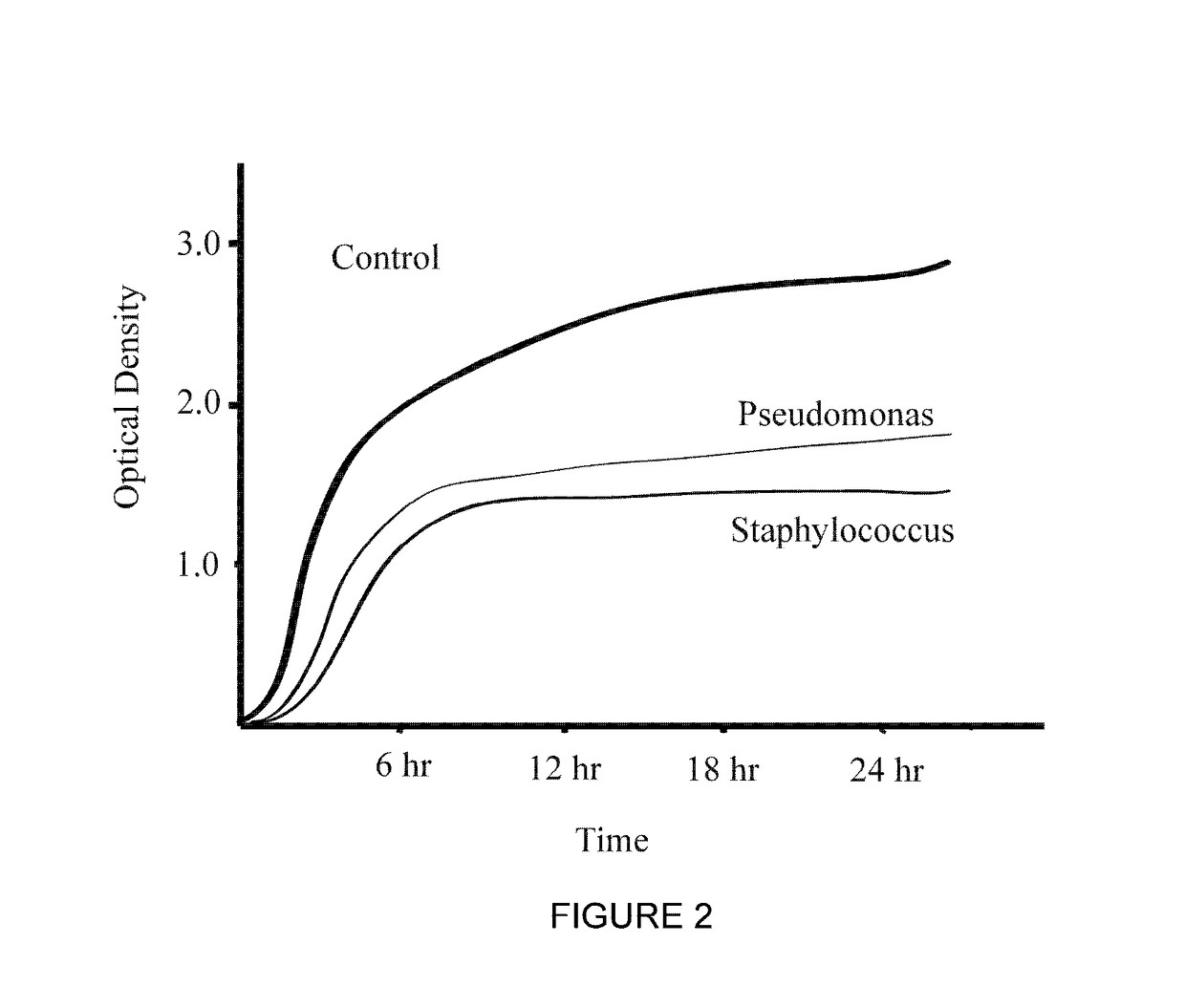Method and composition for bacterial or fungal suppression on skin
a technology of bacterial or fungal growth and composition, applied in the field of method and composition for suppressing bacterial or fungal growth on the skin, can solve problems such as surgical incision infection, and achieve the effect of suppressing bacterial or fungal growth and limiting their application
- Summary
- Abstract
- Description
- Claims
- Application Information
AI Technical Summary
Benefits of technology
Problems solved by technology
Method used
Image
Examples
example 1
[0048]Conjugated linoleic acid (80%) and conjugated linoleic acid diglyceride, containing both trans and cis isomers, were used to show persisting reduction of bacterial growth over several hours. Each measure was accomplished in separate wells. Each well received a unique combination of the following, including controls.
[0049]Conjugated linoleic acid 80% and conjugated linoleic acid diglyceride, 25 uL were each separately added to Trypticase Soy Broth (TSB). To each solution was added 75 uL TSB plus 50 uL staphylococcus aureus (ATCC 6366) or pseudomonas aeruginosa (ATCC 15442). This was then entered into a 27 hour kinetic assay using a redox active dye to monitor growth. Appropriate controls were simultaneously run.
[0050]The results for staphylococcus aureus unexpectedly show a reduction in bacterial growth beginning at 30 minutes, sustained for 20 hours. The results for pseudomonas aeruginosa unexpectedly show a reduction in bacterial growth beginning at 200 minutes, sustained for...
example 2
[0051]Superfatted conjugated linoleic acid soap (500 ml of water containing 20 g potassium hydroxide and 20 g aspartic acid added to 105 g CLA free fatty acid) was used to show the unexpected persisting reduction of bacterial growth over several hours.
[0052]An overnight culture of each organism to be tested was added to aliquots of the CLA soap along with TSB (a growth media for bacteria). These samples were placed in a bactometer cartridge and subsequently placed in the bactometer at 30° C. for 72 hours. The electrical impedance readings over time were measured to generate a growth curve. The microbes tested were pseudomonas aeruginosa ATCC 15442, staphylococcus aureus (methicillin resistant) ATCC 33591, candida albicans ATCC 10231, and enterococcus faecium (vancomycin resistant) ATCC 51559. The total volume of each well was 1.5 ml, 0.5 ml soap or TSB, and 0.5 ml TSB growth medium.
[0053]The results for pseudomonas shows a 9.1 log reduction in bacteria beginning at 1 hour and extend...
example 3
[0055]CLA free fatty acid oil was applied twice daily directly to skin with acne. After 24 hours, unexpectedly, there was substantial reduction in the size and redness of the acne.
[0056]It is known in the art that sebaceous glands may produce sebum which may build up behind the blockage of blocked skin pores. This built up sebum may harbor various forms of acne causing bacteria, including Propionibacterium acne and other bacteria. Therefore, this example shows that CLA is effective in reducing the growth rate of acne causing bacteria.
PUM
| Property | Measurement | Unit |
|---|---|---|
| total volume | aaaaa | aaaaa |
| total volume | aaaaa | aaaaa |
| time | aaaaa | aaaaa |
Abstract
Description
Claims
Application Information
 Login to View More
Login to View More - R&D
- Intellectual Property
- Life Sciences
- Materials
- Tech Scout
- Unparalleled Data Quality
- Higher Quality Content
- 60% Fewer Hallucinations
Browse by: Latest US Patents, China's latest patents, Technical Efficacy Thesaurus, Application Domain, Technology Topic, Popular Technical Reports.
© 2025 PatSnap. All rights reserved.Legal|Privacy policy|Modern Slavery Act Transparency Statement|Sitemap|About US| Contact US: help@patsnap.com



